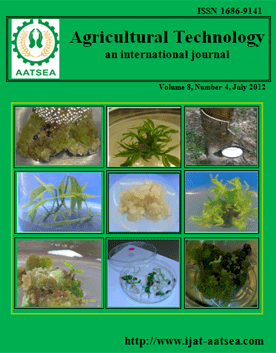ThaiScience
ThaiScience
INTERNATIONAL JOURNAL OF AGRICULTURAL TECHNOLOGY
Volume 17, No. 01, Month JANUARY, Year 2021, Pages 277 - 290
Economic analysis of cassava production in cambodia
Peuo, V., Mimgratok, S., Chimliang, T., Yagura, K., Huon, T. and Peuo, P.
Abstract Download PDF
The research indicated that the farmers had an average land holding over 7 hectares, with 58% of their land used for planted cassava. For the fresh root cassava, the yield ranged from 8.40 to 37.26 tonnes per hectare, with an average of 24.16 tonnes per hectare. The value-added and net profit represented 83.09% of the total production and 28.82% per hectare. The production cost was 1,058.19 USD per hectare and the break-even point was 43.79 USD per ton, with a return on investment of 1.40 USD. The dried chips cassava showing the value-added and net profit of the total production that accounted at 87.07%, and 33.21% per hectare, respectively. The dried cassava production, it involved a process of peeling and drying the fresh cassava, and the cost of that process was 19.56 USD per ton. The labour revealed mostly hired on cassava production which represented a cost of 21 to 25% of the revenue from the sale of their final products. Furthermore, the farmer"es profit was reduced by 24% due to yield variation, although the price fluctuation was not a big issue. In addition, there was a high production cost, a poor investment in the processing of raw materials, and a dependence on the Thai export traders to the Chinese market. Therefore, it was undeniable that the price of cassava is a determinant factor that could represent a significant loss of added value in Cambodia.
Keywords
Break-even point, Economic, Value-added, Return on investment, SWOTINTERNATIONAL JOURNAL OF AGRICULTURAL TECHNOLOGY
Published by : Association of Agricultural Technology in Southeast Asia (AATSEA)
Contributions welcome at : http://www.ijat-aatsea.com
